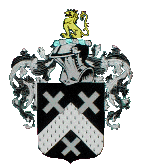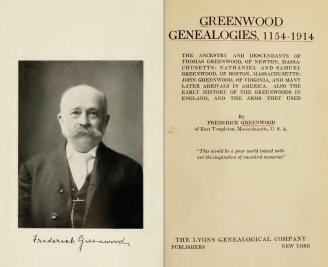
|
The Greenwood Family History and One Name Study
The website dedicated to the research of the Greenwood family name worldwide
Registered with the Guild of One Name Studies (member 4710)
|
| Home The Greenwood Name Famous Greenwoods Greenwood Records Greenwood Photos Contact Us |

GREENWOOD GENEALOGIES, 1154-1914By Frederick Greenwood, East Templeton, MA - 1914Chapter X - ENGLISH HISTORY OF THE FAMILY & ORIGIN OF THE NAMEFor full seven centuries the surname Greenwood has been in use in England. The early English Greenwood records given in this volume and a long Greenwood pedigree now in the College of Arms, in London, Eng., show the progenitor of the Greenwood family in England to have been a Wyomarus de Greenwode. All family records of Anglo-Saxon extraction are believed to run back to this Wyomarus and the name Greenwood may be regarded as having had its beginning with him. This Wyomarus was caterer to Maud, the Empress, mother of King Henry II, who reigned in England A.D. 1154-1189. Wyomarus furnished the provisions for the household of the Empress Maud (known also as Matilda) and was of the titled gentry or nobility of his time. His coat of arms, which all Greenwoods are entitled to use, appears in this volume. In the township of Heptonstall, Eng. (which is in the West Riding of Yorkshire), 1-1/2 miles from Heptonstall village, on the old Roman highway, which leads from Heptonstall to Colne, there stands today a grand old hall or manor house, built of hand-hewed stone. This house, which is of such ample pretensions as to be known as a mansion, has for many centuries been standing here. It is set high up on the slope of what is known as Hardcastle Crags, or Hebden Valley. It overlooks this beautiful, wooded valley and the scene presented is picturesque and enchanting. Many tourists are attracted to this spot by the grandeur of the scene. According to Thoresby's history of Leeds, published 1715, and from the records which appear in this volume, this mansion was built by Wyomarus or his immediate descendants and was their home place. The mansion with its buildings and land attached is known as Greenwood Lee. The mansion is 20 miles due west from Leeds and is 2 miles distant from the flourishing cotton manufacturing town of Hebden Bridge. Three-fourths of a mile from Greenwood Lee, on the same old Roman road leading from Heptonstall to Colne, is a second building of stone and is known as High Greenwood. This structure was rebuilt 100 years ago and is now much changed from its former appearance. In the neighborhood of Greenwood Lee and High Greenwood there are today such places as Greenwood Lee Wood, High Greenwood Wood, Greenwood Lee Clough, Green Hill and others, and the public records of Heptonstall show that these places were formerly included in what was once known as Greenwood. It was a little settlement in itself. At one time this tract was a forest and this little settlement took its name from that forest. It was a large tract of green wood, of waving trees of oak, ash, maple and birch and many other varieties of wood. Probably the forest from which Greenwood took its name included the whole district from Stoneshay Gate to Widdop Gate and from the right side of the highway down to the river Hebden in the valley. The clearing in the forest was begun on the plateau skirting the valley. Here Greenwood Lee was built. It is possible that the first houses were of wood and then after the forest was somewhat cleared Greenwood Lee was constructed; then followed the construction of High Greenwood, the Clough house and others. This settlement of Greenwood was one of the oldest in Heptonstall and the Greenwoods of the settlement from ancient times down to the present day have ever been prominent in shaping the history of that old town. Turn over the pages of history of old Heptonstall, either of its remote past or immediate present, and the name Greenwood stands out prominent before you. Whichever way you turn in Heptonstall you are confronted by that name. The largest tax payers of Heptonstall have ever been Greenwoods, while the records of the ancient parish church of the place and the old wills recorded at York show generous contributions by Greenwoods to the church and large bequests to public charity. |
| © 1997-2026 - John Greenwood | Home | The Greenwood Name | Famous Greenwoods | Greenwood Records | Greenwood Photos | Contact Us | Website by greenwood-IT.co.uk |